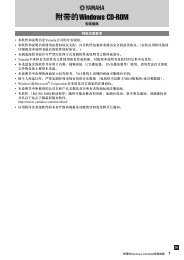Create successful ePaper yourself
Turn your PDF publications into a flip-book with our unique Google optimized e-Paper software.
Using the Groove Check Function<br />
When you play along with a song or the metronome, the Groove Check function compares your<br />
timing with the clock used for song or metronome playback and lets you know how accurate you<br />
are. Along with timing, the <strong>DTXPLORER</strong> gives you a graphic display of trigger levels so you can<br />
see how uniform your playing is.<br />
1. Select a Song or a Click Set<br />
First, select the song or click set that you want to play along<br />
with.<br />
2. Groove Check Display<br />
Press the [SHIFT] + [CLICK] buttons to view the Groove<br />
Check’s (GRV1) main display.<br />
Rotate the jog dial to set the song’s or metronome’s tempo<br />
(q=30 to 300).<br />
3. Select the Pad<br />
Press the [>] button to view page GRV2, then rotate the jog<br />
dial to select the pad (Trigger Input Source) that you want to<br />
check. The “ALL” setting selects all pads.<br />
Range: snare, tom1, ... pad9, ALL<br />
4. Set the Timing (Note Value)<br />
Press the [>] button to view page GRV3, then rotate the jog<br />
dial to select the note value of the timing you want to check.<br />
Range: A”, «(4), †(8), ©(16), Œ<br />
5. Set the Rhythm Gate<br />
If needed, press the [>] button to view page GRV4 and set<br />
the rhythm gate. This function defines how early or late your<br />
timing can be when you play. If the timing of the note you<br />
play obviously differs from the note value set in page GRV3,<br />
the Rhythm Gate will not allow the note’s sound be produced.<br />
Range: off, easy, norm, pro<br />
GRV1 æææ¿æ‘æ---ƒ=120<br />
Gr=-1œ1.5‚<br />
Tempo<br />
GRV2 Parameter<br />
– Input=snare ‚<br />
GRV3 Parameter<br />
– Note=«(4) ‚<br />
GRV4 Parameter<br />
–RhythmGate=easy<br />
The gate increasingly narrows as the setting changes from<br />
“easy” to “norm” to “pro”. In other words, the higher the level,<br />
the greater amount of precision required to produce sound.<br />
Set it to “off” and everything you play will be produced.<br />
* The Rhythm Gate function only operates when the Groove<br />
Check’s (GRV1) main display is being viewed.<br />
6. Start the Groove Check!<br />
After setup is complete, go back to the Groove Check’s main<br />
menu (the GRV1 page) and start song playback ([SONG >/<br />
■]) or metronome playback ([ ON/OFF]).<br />
7. Play with Accuracy<br />
Listen to the song or metronome and concentrate on the playing<br />
the pads accurately. The jog dial can be used to adjust<br />
the tempo for the song or metronome.<br />
The meter in the upper half of the display gives a graphic<br />
indication of the inaccuracy in timing of each note played<br />
and the trigger input level. If your timing is slower than just<br />
time, the mark will move to the right side of the display. If<br />
your timing is early, the mark will move to the left.<br />
Data shown in the lower half of the display are for tempo,<br />
the average inaccuracies in timing as compared to the note<br />
value set in page GRV3, and the deviation of each shot.<br />
Timing display<br />
Note value set in page GRV3<br />
B A B A B A B<br />
A: Range within sound can be produced.<br />
B: Range within sound will not be produced even<br />
though the pad is struck.<br />
GRV1 æææ¿æ‘æ---ƒ=120<br />
Gr=-1œ1.5‚<br />
Tempo<br />
Indicates Pad Input<br />
(Trigger Input level)<br />
Deviation in timing inaccuracy<br />
(0.0 to 9.9)<br />
Average inaccuracy in timing<br />
(-9 to +9)<br />
* How the timing is displayed (Guide to values in the display)<br />
0 (just), 1 to 9 (unit is 1/24 of a 16 th note)<br />
* The Groove Check’s results are reset the next time song or<br />
metronome starts playing.<br />
19















![Premere il pulsante [SONG] - Yamaha](https://img.yumpu.com/50419553/1/184x260/premere-il-pulsante-song-yamaha.jpg?quality=85)

